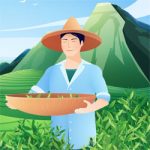
If you are referring to true teas, then there are six types of teas. In the case of herbal teas, however, there are possibly hundreds.
As a dietician, I do have to keep track of the various classifications of tea. This is because they each have their own independent benefits. Thus, I need to advise my clients about which brew is best for them.
In the following post, I will be talking about the types of tea, how they differ and give you some insight into herbal teas as well. Let’s begin our tea journey!
Contents
The first thing that you should be clear on are what true teas actually are. These are leaves are from the camellia sinensis plant, which is often referred to as the tea plant. Camellia sinensis offers six different types of tea. These are:
In addition to being derived from the same camellia sinensis plant, these teas also share certain health benefits. The antioxidants, catechins, and polyphenols can boost everything from heart health to diabetes.
The growing and processing methods for the teas are what causes the discrepancy in the health benefits. It is also what lends to variation in taste. Another identifying characteristic is caffeine. Every true tea has some caffeine, but most herbal teas don't contain it.
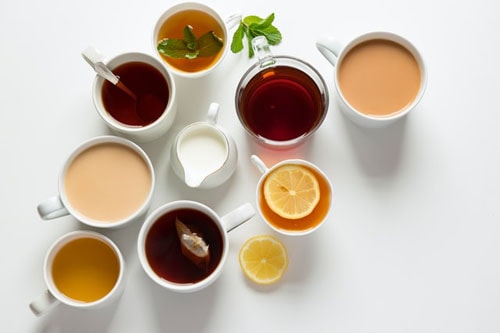
As mentioned, all true teas have caffeine. However, there are some misconceptions about the actual level of caffeine in each kind of tea. For instance, many people that black tea has more caffeine than green tea. This isn't necessarily the case.
The exact level of caffeine in the tea can depend on a number of factors including the fermentation process as well as how the leaves are treated. There is also the fact that the manner in which the tea is brewed can also determine how much caffeine ends up in each cup.
As a rule of thumb, though, lighter teas like white tea has much less than a dark blend like black tea.
Now, most true teas can be decaffeinated. It should be noted that this doesn't make them completely caffeine free, though. These beverages will simply have less caffeine - the levels will not be completely depleted.
Let's take a closer look at the many different types of true tea:
Black tea is arguably one of the better known brews - it is a fully oxidized tea. The leaves are first exposed to air, which begins the oxidation process. During this time, the teas turn a deep brown color and the flavor of the brew is elevated. The next step involves heating, drying, and sometimes crushing the leaves.
These tea leaves produce a dark tea. Due to its reddish hue, it is sometimes referred to as red tea as well. However, due to the darker leaves, it is still classified as black tea. It should be noted that black tea can vary in flavor. While the flavors are often bold and robust, the flavor profile can vary from malty and earthy to nutty and caramel-like.
When making black tea, you have to boiled water and have to allow the tea to steep for several minutes. It is meant to be drunk plain, usually with a splash of lemon. However, it isn't uncommon for people to add milk and sugar as well.
With more premium teas, it is best to limit how much you add these ingredients as they can corrupt the original taste of the tea.
Some of the more well-known black teas are:
Now, there are some kinds of black tea that don't necessarily fall under the category of "type". These include English Breakfast tea, Irish Breakfast tea, Earl Grey tea, masala chai, etc. They contain black tea, but often more than one type.
In the case of Earl Grey, there is also the addition of bergamot oil. Thus, they are considered as tea blends. With chai tea, there is also the addition of spices such as cardamom, cloves, cinnamon, peppercorns, and more.
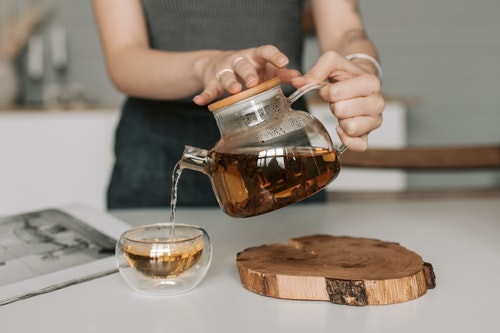
Green tea has skyrocketed in popularity recently as it is associated with numerous health benefits. Unlike black tea, green tea doesn't undergo the oxidation process at all. Instead, it is withered, steam or pan-fired, and dried before the leaves are rolled. It is because it is minimally processed that it maintains its bright green color.
It should be noted that green tea can be classified as either Chinese green teas or Japanese green teas. They are grown in different ways and are processed separaly as well. Thus, the Japanese green teas can taste quite differnt to the Chinese version.
The flavors tend to vary quite a bit with green teas as well. In some cases, it can be grassy and vegetal. In other instances, it may actually be rather sweet and delicate, with a mellow flavor. Contrary to popular belief, green tea shouldn't be all that bitter.
Green tea is meant to be consumed as it is. Adding any other ingredients will completely destroy the natural taste of the drink. In some instances, components like milk can actually counteract the natural benefits of the green tea.
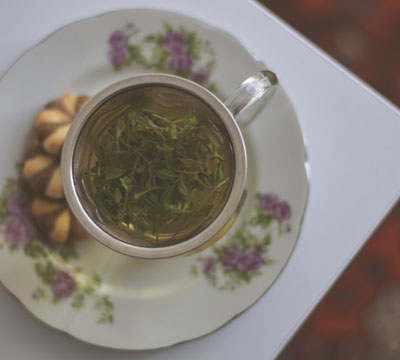
White tea is harvested at the beginning of the season. Only the young leaves are plucked for this brew. Once harvested, the leaves are immediately withered and dried to prevent oxidation. The resulting brew is quite light in both color and flavor. White teas do tend to be more expensive due to their specific harvesting requirements.
White tea is actually light and refreshing, with a delicate flavor. Its flavor characteristics can be described as sweet and vegetal. As the tea is quite so delicate, adding any milk, sugar, or other additives is frowned upon.
Oolong tea is known as partially oxidized tea. Oolongs can vary quite a bit and are one of the more complex teas out there. These leaves can be processed in a wide variety of ways. The exact process used will yield different flavors and aromas.
As such, there are so many different flavor profiles to choose from here. Some are floral and grassy, similar to that of a green tea. On the other end of the spectrum, sweet and toasty.
Of all the true teas, pu erh tea undergoes the most during the fermentation process. This is why it is often referred to as fermented tea. Unlike with other teas, the fresh tea leaves here are hand tossed in a wok to stop the oxidation process. At the same time, there is just enough bacteria for fermentation to take place.
The taste of pu erh evolves as it ages. Therefore, it may start off with a bittersweet flavor and then end up along the lines of sour and earthy. Due to this, it can be difficult to know what to expect with the flavor profile.
This is an incredibly rare tea. In fact, most people don't even realize that it exists or even that this type of tea belongs to the true tea classification. Yellow and green tea have similar processing methods. They are initially processed in the same way - the main difference is that with the yellow brew, the tea leaves undergo a process that is known as yellowing.
This tea certainly has one of the more unique flavors compared to the other teas. However, it is quite pleasant. It can be described as light and sweet, although it becomes more flavorful the longer that the leaves are brewed for.
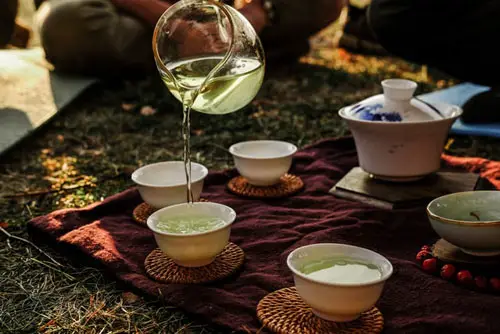
When considering different types of tea, then flavored teas would certainly need to be mentioned. But, what are they? This is where flavor is added to true tea. This can be in the form of flavorings and essences.
The higher end brands will add flavor via extract. This is where the oils are extracted from fruits or blossoms and then added to the tea leaves. In other instances, herbal infusions or inclusions such as blossoms, flowers, or dried fruit may be added.
It would technically not be possible the count the types of herbal tea available. This is because this term can be applied to any flower, root, bark, stem, or fruit that can be turned into tea. In many instances, different types of herbal teas are blended together as well.
As with teas derived from camellia sinensis, herbal tea can be available in two main forms. The first is as whole, dried petals, fruits, roots, etc. These often have to be steeped in water for far longer - hours at a time, in some cases. Then, there are the bagged versions. These tend to be more processed. They only have to be steeped for a few minutes at a time.
Due to the sheer number of types of tea here, I'm going to limit my list to the most popular kinds. Even then, there are many teas to go through:
Chamomile is arguably one of the most consumed herbal concoctions around. The tea is made from the dried flowers of the plant. Chamomile has long been used to treat a wide variety of ailments in humans. These days, though, it is largely drunk for its calming and sleep-inducing properties. It can be quite potent as remedy for various skin issues such as eczema and rashes. Chamomile is often given to individuals suffering from different digestive issues as well.
This is yet another tisane that you will find in numerous households. Peppermint has a long history of being used to treat digestive ailments. It is particularly helpful with sensitive stomachs and digestive systems. At the same time, peppermint is a refreshing tea. It is often drunk for its revitalizing properties as well. Its familiar and appetizing flavor makes it a favorite as well.
Ginger tea definitely deserves a place at the top of this list. Most people like this drink as they find the warm and spicy taste rather comforting. It also works well when mixed with other aromas and herbal drinks.
At the same time, ginger is great for warding off nausea and settling stomachs in general. It is one of the few herbal concoctions that are easy to make from scratch. As the ingredient is readily available, it can simply be sliced up and allowed to steep in hot water.
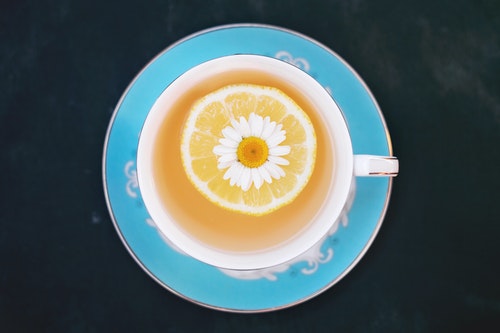
Rooibos is also known as red bush tea and has been dominating the market for a while now. One of the draws of this tisane is the flavor. It is sweet, smooth, and even has a hint of vanilla to it. What's really impressive about it, though, are the purpoted health attributes.
There is some evidence that rooibos could help with heart health, diabetes, has anti-inflammatory effects, and can even help to lower blood pressure. At the same time, there are some side effects associated with the drink.
For one thing, rooibos has estrogen-like effects on your body. You may also want to avoid it if you are currently undergoing chemotherapy or are concerned about liver health. In general, it is best to speak with your doctor before you drink rooibos, particularly on a regular basis.
This tisane is one of the only kinds of herbal tea to contain caffeine - as much as black tea. As a result, it is often used to help with weight loss, fatigue, and headaches. There still needs to be quite a bit of research done regarding the drink.
It is best to drink yerba mate in smaller quantities and at cooler levels. In high quantities and at higher temperatures, it appears to increase the risk of various cancers. Thus, moderation is key here.
The drink made from hibiscus petals is actually quite tart, but still delicious. Most people also drink it for its nutrient value. There is some evidence that the tea could help with high blood pressure, diabetes, and high cholesterol.
In moderate amounts, hibiscus is perfectly fine. However, overconsumption can result in dizziness and fatigue. It is possible that it may negatively interact with hypertensive, diabetic, and other medications. It may also reduce the efficacy of certain types of birth control. Due to this, it is important to speak to a healthcare specialist before adding hibiscus tea to your diet.
This is also known as blue tea due to the distinctive blue hue that the plant gives off when steeped in water. One of the reasons that this drink has become so popular is due to its color changing abilities - it acts as a universal indicator.
This means that if you add alkaline or acidic components to the drink, they will change color accordingly. It is a treat to have at gatherings and is sometimes used as an ingredient for cocktails as well. It should be noted that butterfly pea flower tea isn't particularly tasty. As such, it is best to add milk and sugar to the drink before consuming it.
These days, you can find various tea blends that reportedly provide you with various benefits. This can be anything from immune support to cold prevention. Now, there may be some truth to these drinks. After all, it is clear that both true and herbal tea can have a wide variety of purposes. However, you should be aware that these advantages may not be as noticeable as the brand claims them to be.
It is also important to consider the ingredients of the tea, how they have been sourced, and the exact quantity in that blend. Then, do your research and make sure that it holds up. You should also know that even healthy components can sometimes have a negative impact on your wellbeing. This is especially true if you are pregnant, have a specific medical condition, or are sensitive to certain ingredients.
As for the weight loss teas, most of these are hoaxes and some are even downright dangerous. Now, if the blend only contains natural and safe ingredients, then it is unlikely to do you any harm. Nevertheless, you may not lose weight at the rate at which you want.
Keep in mind that some weight loss teas actually contain ingredients such as diuretics and laxatives. These can be harmful and can leave you feeling rather ill as well. Always read the ingredients ahead of time and steer clear of any brands that include these components in their blends.
Related Articles:
The Best Oolong Tea for Weight Loss - Ooh La La Indeed
Black Tea for Weight Loss - There's More To It Than You Think
Best Green Tea Brands for Weight Loss - Top of The Class
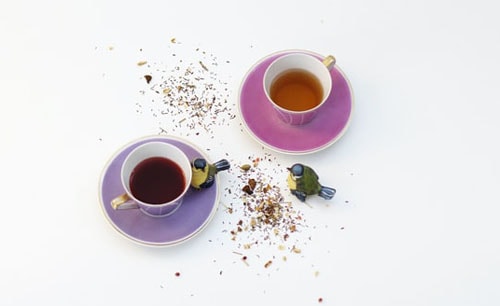
In addition to all the tea varieties, teas can also be classified by how they are packaged and consequently steeped. The top forms that you can purchase tea is as whole leaf tea, tea bags, and instant tea powder. Here is some more information about these tea types:
Here, the tea leaves are almost completely whole - this means that they haven't been cut in any way. These teas can either be rolled into small balls or left as whole tea leaves. A certified tea sommelier and other expert tea drinkers would agree that this is the best way to experience tea.
In fact, you will often find that premium Chinese tea and Japanese tea are only available in this form. This is especially true for more delicate teas such as green and white. For one thing, such teas have been minimally processed, leaving their unique flavors intact. For another, loose tea leaves can be steeped more effectively. Thus, the leaves can unfurl and release a variety of complex profiles.
Leaves such as these often have to be used with some kind of strainer or infuser. This allows you to discard the leaves when you are done steeping.
As you can imagine, tea bags are the most preferred form of packaging and it is easy to see why. Here, all you need is a cup and hot water and you are good to go. It is also far easier to discard the leaves when you are done as they enclosed in a bag.
Many would argue that your tea experience isn't as great with tea bags as the type of tea in these bags tends to be inferior. However, this isn't always the case. As there has been an increased interest in healthy beverages, there has been a rise in premium tea bags. Here, the bags contains larger leaves. In turn, this offers up a better taste. It is now also possible to find bags that are a bit more eco-friendly as well.
Of course, people are always looking for easier and easier ways to get their tea fix. This is why instant tea powder is found a lot more commonly. It is similar to the concept of instant coffee. Add water to the powder and you have a drink with virtually no residue left. The benefit, of course, is that there is less mess to clean up.
It goes without saying that the powder doesn't taste quite as good as the beverage produced by tea bags or leaves. Thus, you often have to add quite a bit of milk and sugar to make it more palatable.
As you can see, types of tea is a pretty wide subject, but certainly a fascinating one. And, now, you know a lot more about all the varieties of tea available to you. This should help you to broaden your horizons quite a bit in the future!
Did you enjoy this post? If so, you should certainly check out our Pinterest page. We have tons of other posts and information about tea and its different varieties. You should certainly check it out!
